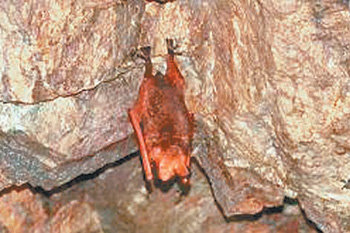Korean orange whiskered bats inhabit in Mt. Wolak and Odae
Korean orange whiskered bats inhabit in Mt. Wolak and Odae
Posted January. 18, 2016 07:37,
Updated January. 19, 2016 13:54

It has been found that Korean orange whiskered bats, an endangered species, inhabit in Mt. Wolak and Odae. The species is also called golden bats as their fur and ears have a clear orange color. It is also a globally endangered species, which is designated as Koreas 452nd natural monument.
The Korean National Park Service said on Sunday that it confirmed the inhabitant of Korean orange whiskered bats, which are a level 1 endangered wild life species, at Mt. Wolak National Park and Mt. Odae National Park from its own study of natural resources and parks last year. The purpose of the study is to identify the diversity of species in the ecology of Baekdudaegan, a mountain range that runs through the Korean Peninsula.
Korean orange whiskered bats hibernate up to 220 days during winter, and even after they wake up from hibernation, they sleep deep in the woods during the day and become active at night. As they often sleep in abandoned mines that keep the temperature of 12 Celsius degrees during winter, they are particularly difficult to discover. The Korean National Park Service said, As we designated Baekdudaegan including Mt. Wolak and Odae as key protection areas and managed them in a systematic manner, we are witnessing a growth in the number of bats inhabiting these areas.
The agency also identified new level 2 endangered wild life species -- the Ussurian tube-nosed bat and the brown long-eared bat in this study. They and the Korean orange whiskered bat are three bats that are in danger of extinction. A past study found that the Ussurian tube-nosed bat and the brown long-eared bat live in Mt. Odae. This latest study found that all three endangered bats inhabit three mountains including Mt. Sobaek, which turned out to have the species in 2014.
lhs@donga.com







